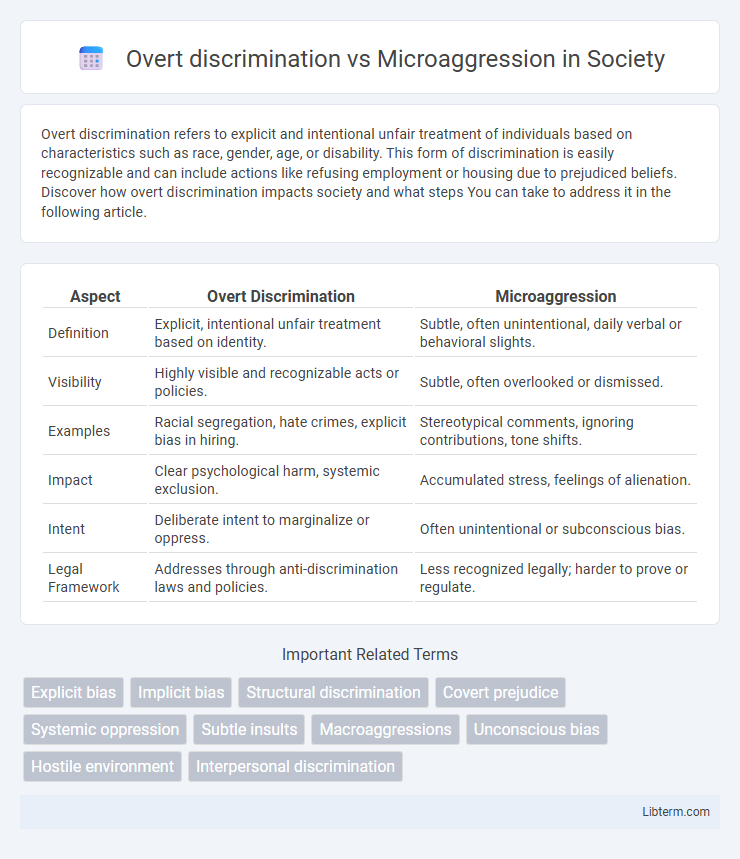Overt discrimination refers to explicit and intentional unfair treatment of individuals based on characteristics such as race, gender, age, or disability. This form of discrimination is easily recognizable and can include actions like refusing employment or housing due to prejudiced beliefs. Discover how overt discrimination impacts society and what steps You can take to address it in the following article.
Table of Comparison
| Aspect | Overt Discrimination | Microaggression |
|---|---|---|
| Definition | Explicit, intentional unfair treatment based on identity. | Subtle, often unintentional, daily verbal or behavioral slights. |
| Visibility | Highly visible and recognizable acts or policies. | Subtle, often overlooked or dismissed. |
| Examples | Racial segregation, hate crimes, explicit bias in hiring. | Stereotypical comments, ignoring contributions, tone shifts. |
| Impact | Clear psychological harm, systemic exclusion. | Accumulated stress, feelings of alienation. |
| Intent | Deliberate intent to marginalize or oppress. | Often unintentional or subconscious bias. |
| Legal Framework | Addresses through anti-discrimination laws and policies. | Less recognized legally; harder to prove or regulate. |
Understanding Overt Discrimination
Overt discrimination involves explicit, intentional actions or policies that treat individuals or groups unfairly based on characteristics like race, gender, or age, often manifested through hate speech, exclusion, or unequal access to opportunities. It is easily identifiable and legally recognizable, resulting in clear consequences or formal complaints in workplaces, schools, or public settings. Understanding overt discrimination requires recognizing its direct impact on victims and addressing systemic barriers through enforceable anti-discrimination laws and organizational policies.
Defining Microaggressions
Microaggressions are subtle, often unintentional, behaviors or comments that convey prejudiced or negative messages toward marginalized groups, distinct from overt discrimination characterized by explicit and intentional acts of bias. These covert expressions include microinsults, microinvalidations, and microassaults that cumulatively impact individuals' mental health and social experiences. Understanding the nuanced nature of microaggressions is essential for addressing systemic discrimination and promoting inclusive environments.
Key Differences Between Overt Discrimination and Microaggressions
Overt discrimination involves explicit, intentional actions or policies that target individuals or groups based on race, gender, or other identities, such as racial slurs or denying employment opportunities. Microaggressions consist of subtle, often unintentional comments or behaviors that communicate derogatory or negative messages to marginalized groups, like backhanded compliments or assumptions based on stereotypes. The key difference lies in the visibility and intent; overt discrimination is blatant and deliberate, while microaggressions are covert and often unconscious, yet both contribute to systemic inequality.
Historical Context of Overt Discrimination
Overt discrimination has deep roots in historical systems such as segregation, Jim Crow laws, and institutionalized racism, which legally enforced unequal treatment based on race, gender, and other identities. These explicit acts of prejudice, including denial of voting rights and employment barriers, shaped social hierarchies and economic disparities for centuries. Understanding this historical context is crucial to recognizing the evolution from blatant discrimination to subtler forms like microaggressions in contemporary society.
Common Examples of Microaggressions
Common examples of microaggressions include subtle verbal comments such as backhanded compliments or dismissive remarks about someone's race, gender, or cultural background. Non-verbal actions like avoidance, eye-rolling, or spacing in conversations also constitute microaggressions that convey underlying prejudice. These behaviors differ from overt discrimination by being indirect, often unconscious, and socially normalized despite their harmful impact.
Impact of Overt Discrimination on Society
Overt discrimination manifests in explicit actions or policies that marginalize specific groups, leading to systemic inequality and social division. This form of discrimination erodes trust in institutions, reduces economic opportunities for affected populations, and fosters environments of hostility and violence. The cumulative impact undermines social cohesion, perpetuates disparities in education, employment, and health outcomes, and obstructs progress toward equity and inclusion.
Psychological Effects of Microaggressions
Microaggressions cause subtle yet pervasive psychological distress, leading to increased stress, anxiety, and lowered self-esteem among marginalized groups. Unlike overt discrimination, which is explicit and often easier to identify, microaggressions accumulate invisibly, eroding mental health over time and contributing to feelings of isolation and invalidation. Research highlights how these seemingly minor slights can trigger chronic stress responses, impacting overall well-being and cognitive functioning.
Identifying Overt Discrimination in the Workplace
Overt discrimination in the workplace is characterized by explicit actions or policies that unfairly treat employees based on race, gender, age, or other protected characteristics, such as denying promotions or unequal pay. Identifying overt discrimination involves recognizing clear evidence like discriminatory language, biased hiring practices, or documented complaints supported by factual data. Employers must implement robust mechanisms, including transparent reporting systems and diversity audits, to detect and address blatant discriminatory behaviors swiftly.
Strategies to Address and Mitigate Microaggressions
Implementing comprehensive training programs that educate individuals about the subtle nature of microaggressions fosters awareness and empathy, crucial for reducing these behaviors. Encouraging open dialogues in workplaces and educational settings creates safe spaces for victims to express experiences, facilitating collective understanding and support. Establishing clear policies for reporting and addressing microaggressions ensures accountability, reinforces organizational commitment to inclusion, and promotes a respectful environment.
Building Inclusive Environments: Steps Forward
Overt discrimination involves explicit actions or policies that unfairly target individuals based on race, gender, or other identities, creating clear barriers to inclusion. Microaggressions are subtle, often unintentional behaviors or comments that perpetuate stereotypes and marginalize marginalized groups in everyday interactions. Building inclusive environments requires proactive training on recognizing both overt discrimination and microaggressions, implementing clear reporting mechanisms, and fostering open dialogue to promote respect and equity within diverse workplaces or communities.
Overt discrimination Infographic

 libterm.com
libterm.com